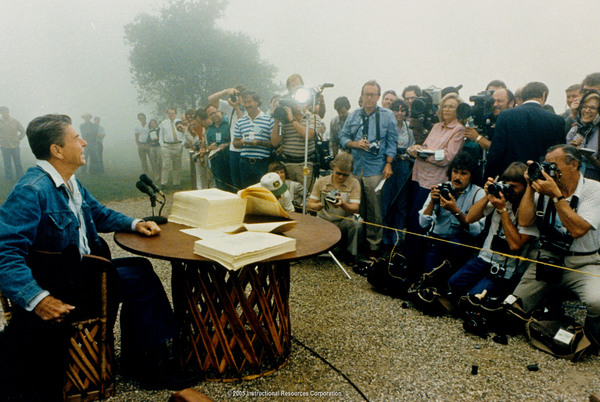Introduction
| Ronald Reagan, two-term governor, U.S. President | |||
 |
|
||
 |
|||
 |
|||
| Ronald Reagan, two-term governor, U.S. president IRC, 2005. Image.
Discovery Education. Web. 15 July 2014. <http://www.discoveryeducation.com/>. |
|||
| President Reagan Signs the Tax Cut Bill | |||
 |
|
||
 |
|||
 |
|||
| President Reagan Signs the Tax Cut Bill IRC, 2005. Image. Discovery Education.Web. 15 July 2014. <http://www.discoveryeducation.com/>. |
|||
| Ronald Reagan near podium with King Fahd speaking | |||
 |
|
||
 |
|||
 |
|||
| Ronald Reagan near podium with King Fahd speaking IRC, 2005. Image.
Discovery Education. Web. 15 July 2014. <http://www.discoveryeducation.com/>. |
|||
| Chinese Troops Entering Korea in Late 1950 | |||
 |
|
||
 |
|||
 |
|||
| Chinese Troops Entering Korea in Late 1950 IRC, 2005. Image.
Discovery Education. Web. 15 July 2014. <http://www.discoveryeducation.com/>. |
|||
Central Question: How did Ronald Reagan use the power of the presidency to influence domestic and foreign affairs?
During the presidential campaign of 1980, former California governor Ronald ReaganPresident of the United States from 1981-1989 asked the American public, "Are you better off now than you were four years ago?" For most Americans, the answer was a resounding "no." The economy remained weak, foreign policy matters appeared to be worsening, and the country seemed stuck in a general sense of malaise. Reagan's offers of hope and a better tomorrow resonated with the American people and contributed to his landslide victory over Carter in 1980.
Upon assuming office, Reagan got to work implementing tax cuts to stimulate the economy. Within two years, the nation showed signs of rebound with a growing economy. On the foreign front, Reagan's strong leadership helped navigate the nation through terrorist threats with Libya and nuclear threats with the Soviet UnionThe U.S.S.R
and nuclear threats with the Soviet UnionThe U.S.S.R Map, Soviet Union and East and South Asia. IRC, 2005. Image. Discovery Education. Web. 15 July 2014.
Map, Soviet Union and East and South Asia. IRC, 2005. Image. Discovery Education. Web. 15 July 2014.
Following successful completion of this lesson, students will be able to:
- Describe the significant domestic and foreign issues of the Reagan administration, including Reaganomics, the Libyan crisis, and the end of the Cold War.
The above objectives correspond with the Alabama Course of Study: US History 11 Objectives: 16 & 16.1.
This lesson incorporates the following Literacy Standards: R1, R2, R3, R7, W4, W7, & W9.



